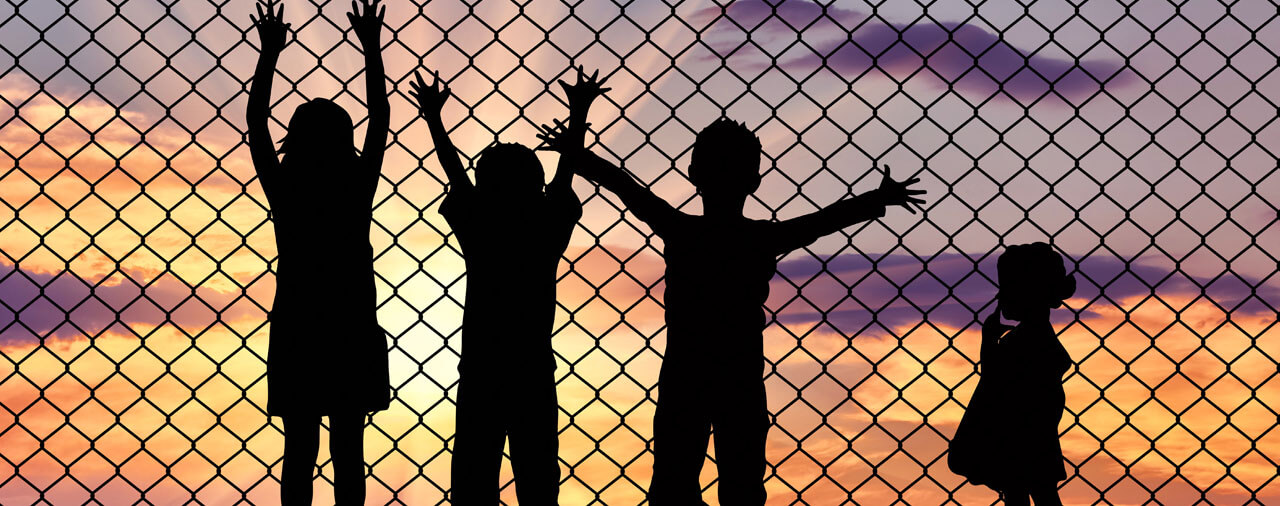Introduction
On February 20, 2017, the Secretary of Homeland Security, John F. Kelly, issued a Department of Homeland Security (DHS) Memorandum titled “Implementing the President’s Border Security and Immigration Enforcement Improvements Policies” (“Border Memo”) [PDF version]. The purpose of the Border Memo is to provide policy guidance regarding the implementation of President Donald Trump’s January 25, 2017, Executive Order 13767 titled “Border Security and Immigration Enforcement Improvements” [82 FR 8793].
In this article, we will review the guidance of the Border Memo regarding the treatment of unaccompanied alien children who are encountered at the border. We will supplement the information in the Border Memo with guidance contained In a February 21, 2017, DHS FAQ titled “Q&A: DHS Implementation of the Executive Order on Border Security and Immigration Enforcement” (“DHS FAQ”) [PDF version]. Furthermore, we will also reference a second Memorandum issued by Secretary Kelly on February 20, 2017, titled “Enforcement of the Immigration Laws to Serve the National Interest” (“Interior Enforcement Memo”) [PDF version].
Please see our overview of both of the Kelly Memoranda along with a table of contents to all of our articles discussing them [see article]. We have also published a comprehensive overview of Secretary Kelly’s Border Memo [see article].
New Rules for Unaccompanied Alien Children
The Border Memo in sections L and M addresses provisions directly related to unaccompanied alien children. Section L discusses the proper processing and treatment of unaccompanied alien children encountered at the border. Notably, it alters the rules for when an alien encountered at the border is defined as an “unaccompanied alien child,” and for ensuring that an alien who is defined as such continues to meet the statutory definition throughout immigration proceedings. Section M provides for an emphasis on enforcing immigration and criminal laws against those who facilitate the smuggling of children across the U.S.-Mexico border. For those interested in following along, you may find these two sections at pages 10-11 of the Border Memo.
The rules in this Memorandum work in concert with other changes introduced in the Border Memo. We encourage you to read our full articles on the Border Memo [see article] and on its new guidelines for expedited removal and immigration detention [see article].
Proper Processing and Treatment of Unaccompanied Alien Minors Encountered at the Border (Sec. L)
Secretary Kelly explains that, as provided in 8 U.S.C. 1232 and 6 U.S.C. 279, unaccompanied alien children receive special protections when encountered at the border. These protections are to ensure “that they are properly processed and receive the appropriate care and placement when they are encountered by an immigration officer.”
In the Border Memo, Secretary Kelly explained that the definition of an unaccompanied alien child is found in 6 U.S.C. 279(g)(2). First, in order to qualify as an unaccompanied alien child, the individual must lack lawful immigration status in the United States and be a minor who has not attained 18 years of age. Additionally, the alien minor must satisfy the one of the following two conditions under statute:
1. Have no parent or legal guardian in the United States; or
2. Have no parent or legal guardian in the United States who is available to provide care and physical custody.
Secretary Kelly explains that under 8 U.S.C. 1232(b)(3), with “limited exceptions,” the United States Customs and Border Protection (CBP) or the United States Immigration and Customs Enforcement (ICE) must determine whether an individual encountered at the border meets the statutory definition of “unaccompanied alien child.” If the alien minor is found to meet the definition of “unaccompanied alien child,” he or she must be transferred to the custody of the Office of Refugee Resettlement under the purview of the Department of Health and Human Services (HHS), “absent exceptional circumstances.” An unaccompanied alien child receives special protections under the immigration law. Secretary Kelly explains that these protections include “placement in a suitable care facility, access to social services, removal proceedings before an immigration judge under section 240 of the [Immigration and Nationality Act (INA)] rather than expedited removal proceedings under section 235(b) of the INA, and initial adjudication of any asylum claim by [the United States Citizenship and Immigration Services (USCIS)].”
Secretary Kelly explains that under existing policy, “[a]pproximately 60% of minors initially determined to be `unaccompanied alien children’ are placed in the care of one or more parents illegally residing in the United States.” Furthermore, under existing DHS practice, such alien minors continued to be treated as unaccompanied alien children, “notwithstanding that they may no longer meet the statutory definition once they have been placed by HHS in the custody of a parent in the United States who can care for the minor.” Secretary Kelly asserted that this “[e]xploitation of that policy led to abuses by many of the parents and legal guardians of those minors and has contributed to significant administrative delays in adjudications by immigration courts and USCIS.”
Secretary Kelly ordered the Director of USCIS, the Commissioner of CBP, and the Director of ICE to develop uniform written guidance and training for all employees and contractors of those agencies regarding the proper processing of unaccompanied alien children. This includes adjudication of claims for relief from removal and safe repatriation, where appropriate. Most significantly, Secretary Kelly ordered the three agency heads to establish standardized review procedures for ensuring that an alien minor who is initially found to be an “unaccompanied alien child” then continues to fall within the statutory definition found in 6 U.S.C. 279(g)(2) “when being considered for the legal protections afforded to such children as they go through the removal process.
Accountability Measures to Protect Alien Children from Exploitation and Prevent Abuses of Our Immigration Laws (Sec. M)
In this section, Secretary Kelly discussed penalizing those individuals in the United States who “conspire to violate our immigration laws” through the direct or indirect facilitation of smuggling alien minors across the border.
Secretary Kelly explains that the parents and family members of unaccompanied alien minors often pay smugglers to bring their children into the United States. Furthermore, Secretary Kelly noted that these parents and family members are often present in the United States without legal authorization. The Secretary stated that many children being smuggled into the United States fall victim to serious crimes in the process. He took the position that,”[r]egardless of the desires for family reunification, or conditions in other countries, the smuggling or trafficking of alien children is intolerable.”
Accordingly, Secretary Kelly ordered the Director of ICE and the Commissioner of CBP to ensure that the immigration laws are properly enforced against any individual who, whether directly or indirectly, “facilitates the illegal smuggling or trafficking of an alien child into the United States.” Secretary Kelly instructed these officials to, in “appropriate cases,” take into account the risk of harm to the child from the specific smuggling or trafficking activity and other factors relevant to the culpability of the perpetrator(s) or the welfare of the alien minor. He explained that proper enforcement includes, but is not limited to, placing the individual(s) involved in removal proceedings or referring the individual(s) for criminal prosecution.
At Q25, the DHS FAQ makes clear that it will transpire that, if an unaccompanied alien minor is reunited with his or her parent or guardian, the parent or guardian could be prosecuted, depending on the facts of the individual case, for having had his or her child smuggled into the United States. However, the DHS FAQ makes explicit that immigration penalties will be imposed and referrals for prosecution will be issued “as appropriate,” rather than as a matter of course.
Analysis
The Border Memo suggests two significant changes regarding the issue of unaccompanied alien children.
The first change is Secretary Kelly’s suggestion that an initial determination that an alien minor is an unaccompanied alien child may be reassessed in the course of immigration proceedings. Under the preexisting policy, an alien minor who is initially determined to be an unaccompanied alien child may continue to be treated as such throughout proceedings. However, Secretary Kelly instructed the relevant DHS agencies to create policies for ensuring that an alien minor continues to meet the definition of an unaccompanied alien child throughout removal proceedings. The Border Memo clearly suggests that placement with a parent or appropriate guardian in the United States would, in most cases, render the alien no longer an unaccompanied alien child.
The second change in policy is the DHS’s promised new enforcement against individuals who facilitate the smuggling or trafficking of an alien minor into the United States. Notably, this can subject the parent or guardian of an unaccompanied alien child to immigration penalties or even criminal referral if he or she is found to have, directly or indirectly, facilitated the smuggling or trafficking of an alien minor into the United States.
Alien smuggling and trafficking was illegal prior to the issuance of President Trump’s Executive Order and Secretary Kelly’s Border Memo. The new policies suggest that the DHS will emphasize enforcing the law against those who facilitate the smuggling or trafficking of alien minors to a greater extent than before. In conjunction with the new stricter policies on qualifying as an unaccompanied alien child, the new rules are clearly designed to discourage alien smuggling and trafficking and relieve backlogs in the immigration courts. If strictly enforced, the new policies will have a substantial effect on the treatment of unaccompanied alien minors encountered at the border. As we noted, 60% of the children initially designated as “unaccompanied alien children” are placed into the care of one or more parents illegally residing in the United States. Secretary Kelly also noted that over the previous three years, “[a]pproximately 155,000 unaccompanied alien children have been apprehended at the southern border…”
Conclusion
Even with the guidelines in the Border Memo, there are still many unanswered questions that will require final guidance from the USCIS, CBP, and ICE. We will update the website with new information once the relevant DHS agencies announce policies to implement the guidance in Secretary Kelly’s Border Memo.





